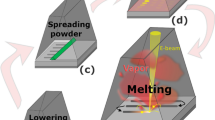Abstract
High-grade ignimbrites are thought to be deposited by pyroclastic flows at temperatures exceeding minimum welding temperature or even solidus temperature. Corresponding pyroclastic-flow particles range from plastic to partially liquid and are able to aggregate or coalesce. This contrasts with particles in pyroclastic flows producing unwelded ignimbrite, which are capable of elastic grain interactions. The low aspect ratio and great areal extent of high-grade ignimbrites requires transport in a particulate state either by (a) high-concentration mass flow facilitated by fluidizing gas reducing internal friction, or by (b) expanded turbulent flow of low but downward increasing concentration. This paper presents experiments designed to investigate the effects of plastic to liquid particles on these two contrasting transport mechanisms. Gas fluidization experiments using polyethyleneglycole (PEG) powders heated above minimum sintering (Tms) and melting (Tm) temperatures cover a wide range of fluidization velocities (Umf>Ua>0.6·Ut) but are always in the bubbly fluidization regime similar to fluidized ignimbrite ash, where particle volume concentration outside the bubbles is high (≈10–1). When the powders reach a critical temperature Tm≥T≥Tms, defluidization by catastrophic particle aggregation immediately commences in both stationary and laterally moving fluidized beds as well as in experiments using mixtures of high- and low-Tm (≥30 wt.%) PEG powders, when T≥Tms of the lower-Tm powder. This indicates that extended particulate transport at T≥Tms is not possible at such high particle concentrations. In the turbulent flow experiments, liquid sprays of molten PEG or water, vertically injected into a high-Re (>104) horizontal air flow, form a low-concentration (10–5 to 10–4) turbulent suspension current. Proximal formation of partially coalesced aggregates, which settle faster than individual particles, causes the measured downstream decay of sedimentation rate to be steeper than predicted by theory of single solid-particle sedimentation from turbulent suspensions. As particles become finer downstream and coalescence efficiency decreases in response to cooling, more distally formed aggregates become too small and rare to modify sedimentation-rate decay from that of suspension flows containing solid particles. The key difference between the two transport systems is particle concentration, C. Since particle collision rate Rcoll∝C2, collision rates in fluidized beds are so high that all particles immediately aggregate when coalescence efficiency (1≥Ecoal≥0) is larger than 10-3. Low-concentration suspensions, on the other hand, require much higher values of Ecoal for significant aggregation to occur. Dilute pyroclastic flows will have higher particle volume fractions (≈10–3) than the experimental currents, but then viscous pyroclasts should have lower coalescence efficiencies than PEG droplets. Experimental results thus support an expanded turbulent transport mechanism of pyroclastic flows generating extensive high-grade ignimbrite sheets.
Similar content being viewed by others
Author information
Authors and Affiliations
Additional information
Received: 28 August 1996 / Accepted: 3 December 1997
Rights and permissions
About this article
Cite this article
Freundt, A. The formation of high-grade ignimbrites, I: Experiments on high- and low-concentration transport systems containing sticky particles. Bull Volcanol 59, 414–435 (1998). https://doi.org/10.1007/s004450050201
Issue Date:
DOI: https://doi.org/10.1007/s004450050201




